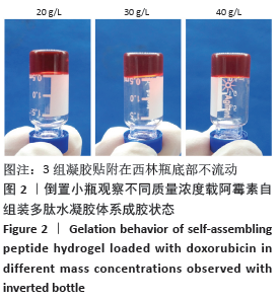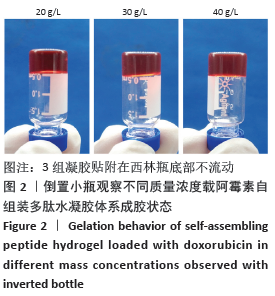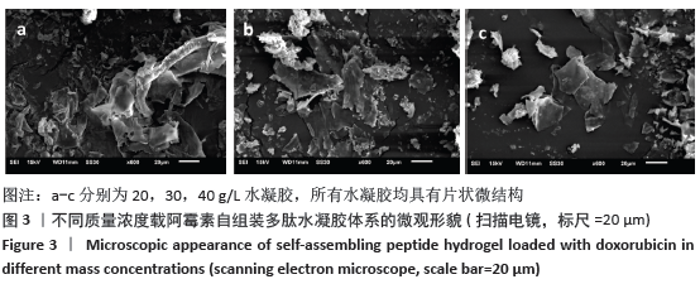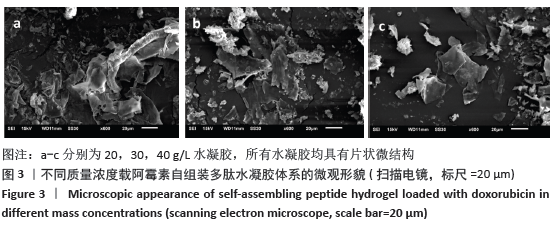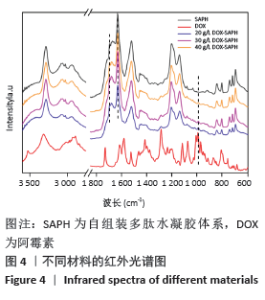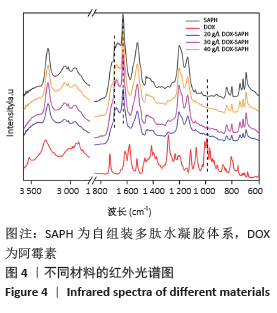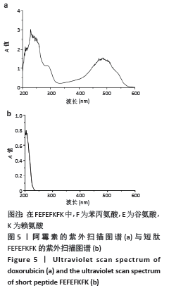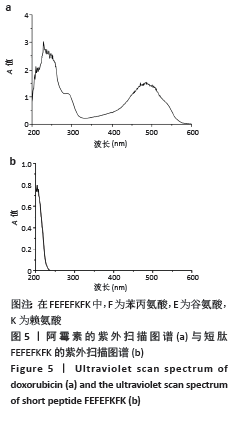Chinese Journal of Tissue Engineering Research ›› 2021, Vol. 25 ›› Issue (16): 2488-2493.doi: 10.3969/j.issn.2095-4344.3114
Previous Articles Next Articles
Preparation and in vitro evaluation of self-assembling peptide hydrogel loaded with doxorubicin
Zhang Xin1, Lu Ying1, Yao Qingqiang2, Zhu Yishen1
- 1Nanjing Tech University, Nanjing 211816, Jiangsu Province, China; 2Department of Orthopedic Surgery, Nanjing First Hospital, Nanjing Medical University, Nanjing 210006, Jiangsu Province, China
-
Received:2020-02-18Revised:2020-02-27Accepted:2020-06-05Online:2021-06-08Published:2021-01-07 -
Contact:Yao Qingqiang, Professor, Department of Orthopedic Surgery, Nanjing First Hospital, Nanjing Medical University, Nanjing 210006, Jiangsu Province, China Zhu Yishen, Professor, The College of Biotechnology and Pharmaceutical Engineering, Nanjing Tech University, Nanjing 211816, Jiangsu Province, China -
About author:Zhang Xin, Master, Nanjing Tech University, Nanjing 211816, Jiangsu Province, China -
Supported by:the Key Project of Social Development in Jiangsu Province, No. BE2019736 (to ZYS)
CLC Number:
Cite this article
Zhang Xin, Lu Ying, Yao Qingqiang, Zhu Yishen. Preparation and in vitro evaluation of self-assembling peptide hydrogel loaded with doxorubicin[J]. Chinese Journal of Tissue Engineering Research, 2021, 25(16): 2488-2493.
share this article
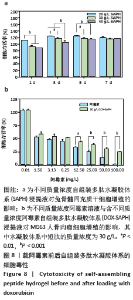
2.6 SAPH体外细胞相容性实验 由CCK-8检测结果可知(图8a),20 g/L SAPH浸提液中第1,3,5 天的兔骨髓间充质干细胞增殖高于30,40 g/L SAPH浸提液(P < 0.05);第7天时,由于皿底细胞量高细胞接触抑制,3组间细胞增殖比较差异无显著性意义(P > 0.05);其中培养第1天时,40 g/L SAPH浸提液中的细胞增殖率为86%,有一定的细胞毒性。结合体外释放率结果,选30 g/L SAPH负载DOX进行细胞毒性实验。 2.7 DOX-SAPH细胞毒性实验 根据图8b结果所示, DOX-SAPH浸提液与DOX溶液都能明显抑制MG63细胞的增殖。DOX-SAPH浸提液的IC50值为6.26 mg/L,DOX溶液的IC50值为2.91 mg/L。当DOX的质量浓度<12.50 mg/L时,DOX溶液和DOX-SAPH浸提液的细胞毒性无明显差异(P > 0.05);当DOX质量浓度≥12.50 mg/L时,与DOX-SAPH浸提液相比,DOX溶液对MG63细胞展现出更强的细胞毒性。"
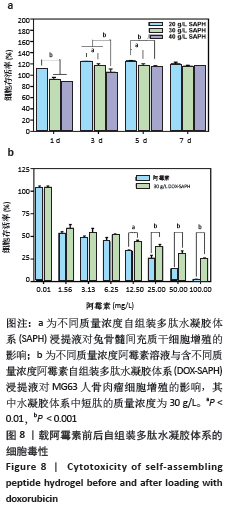
| [1] MISAGHI A, GOLDIN A, AWAD M, et al. Osteosarcoma: a comprehensive review. Sicot J. 2018;4(12):1-8. [2] MA H, HE C, CHENG Y, et al. Localized Co-delivery of Doxorubicin, Cisplatin, and Methotrexate by Thermosensitive Hydrogels for Enhanced Osteosarcoma Treatment. ACS Appl Mater Interfaces. 2015;7(49): 27040-27048. [3] 牛晓辉.骨肉瘤治疗的历史、现状和未来[J].骨科临床与研究杂志,2019, 4(5):257-260. [4] DAHLIN DC, COVENTRY MB. Osteogenic sarcoma. A study of six hundred cases. J Bone Joint Surg Am. 1967;49(1):101-110. [5] MARCOVE RC, MIKE V, HAJEK JV, et al. Osteogenic sarcoma under the age of Twenty-one: review of one hundred and forty-five operative cases. J Bone Joint Surg Am. 1970;52(3):411-423. [6] GIANFERANTE DM, MIRABELLO L, SAVAGE SA. Germline and somatic genetics of osteosarcoma-connecting aetiology biology and therapy. Nat Rev Endocrinol. 2017;13(8):480-491. [7] HARRISON DJ, GELLER DS, GILL JD, et al. Current and future therapeutic approaches for osteosarcoma. Expert Rev Anticancer. 2017;18(1):39-50. [8] ZHANG B, SHAN Y, CHEN K. A facile approach to fabricate of photothermal functional Fe3O4@CuS microspheres. Mater Chem Phys. 2017;193:82-88. [9] HATTINGER CM, FANELLI M, TAVANTI E, et al. Advances in emerging drugs for osteosarcoma. Expert Opin Emerg Dr. 2015;20(3):495-514. [10] SMORENBURG CH, DE GROOT SM, VAN LEEUWEN-STOK AE, et al. A randomized phase III study comparing pegylated liposomal doxorubicin with capecitabine as first-line chemotherapy in elderly patients with metastatic breast cancer: results of the OMEGA study of the Dutch Breast Cancer Research Group BOOG. Ann oncol. 2014;25(3):599-605. [11] ALHOWAIL AH, BLOEMER J, MAJRASHI M, et al. Doxorubicin-induced neurotoxicity is associated with acute alterations in synaptic plasticity, apoptosis, and lipid peroxidation. Toxicol Mech Method. 2019;29(6): 457-466. [12] VEJPONGSA P, YEH ETH. Prevention of anthracycline-induced cardiotoxicity: challenges and opportunities. J Am Coll Cardiol. 2014;64(9):938-945. [13] HAGHIRALSADAT F, AMOABEDINY G, SHEIKHHA MH, et al. New liposomal doxorubicin nanoformulation for osteosarcoma: Drug release kinetic study based on thermo and pH sensitivity. Chem Biol Drug Des. 2017;90(3): 368-379. [14] JONKER AM, LöWIK DWPM , VAN HEST JCM. Peptide- and Protein-Based Hydrogels. Chem Mater. 2012;24(5):759-773. [15] TAO H, WU Y, LI H, et al. BMP7-Based Functionalized Self-Assembling Peptides for Nucleus Pulposus Tissue Engineering. ACS Appl Mater Inter. 2015;7(31):17076-17087. [16] SARKAR B, NGUYEN PK, GAO W, et al. Angiogenic Self-Assembling Peptide Scaffolds for Functional Tissue Regeneration. Biomacromolecules. 2018; 19(9):3597-3611. [17] KARAVASILI C, ANDREADIS DA, KATSAMENIS OL, et al. Synergistic Antitumor Potency of a Self-Assembling Peptide Hydrogel for the Local Co-delivery of Doxorubicin and Curcumin in the Treatment of Head and Neck Cancer. Mol Pharmaceutic. 2019;16(6):2326-2341. [18] PHIPPS MC, MONTE F, MEHTA M, et al. Intraosseous Delivery of Bone Morphogenic Protein-2 Using a Self-Assembling Peptide Hydrogel. Biomacromolecules. 2016;17(7):2329-2336. [19] KARAVASILI C, KOMNENOU A, KATSAMENIS OL, et al. Self-Assembling Peptide Nanofiber Hydrogels for Controlled Ocular Delivery of Timolol Maleate. ACS Biomater Sci Eng. 2017;3(12):3386-3394. [20] DAO HM, CHEN J, TUCKER BS, et al. Hemopressin-Based pH-Sensitive Hydrogel: A Potential Bioactive Platform for Drug Delivery. ACS Biomater Sci Eng. 2018;4(7):2435-2442. [21] WANG Y, CUI M, JIAO M, et al. Antifouling and ultrasensitive biosensing interface based on self-assembled peptide and aptamer on macroporous gold for electrochemical detection of immunoglobulin E in serum. Anal Bioanal Chem. 2018;410(23):5871-5878. [22] LOWIK DW, LEUNISSEN EH, VAN DEN HEUVEL M, et al. Stimulus responsive peptide based materials. Chem Soc Rev. 2010;39(9):3394-3412. [23] CUI M, WANG Y, JIAO M, et al. Mixed Self-Assembled Aptamer and Newly Designed Zwitterionic Peptide as Antifouling Biosensing Interface for Electrochemical Detection of alpha-Fetoprotein. ACS Sens. 2017;2(4): 490-494. [24] LI L, LI JY, GUO JM, et al. 3D Molecularly Functionalized Cell-Free Biomimetic Scaffolds for Osteochondral Regeneration. Adv Funct Mater. 2018;29(6): 1807356.1-1807356.12. [25] FREEMAN R, BOEKHOVEN J, DICKERSON MB, et al. Biopolymers and supramolecular polymers as biomaterials for biomedicals for biomedical applications. MRS Bull. 2015;40(12):1089-1101. [26] SENAPATI S, MAHANTA AK, KUMAR S, et al. Controlled drug delivery vehicles for cancer treatment and their performance. Signal Transduct Tar. 2018; 3(1):7. [27] KARAVASILI C, PANTERIS E, VIZIRIANAKIS IS, et al. Chemotherapeutic Delivery from a Self-Assembling Peptide Nanofiber Hydrogel for the Management of Glioblastoma. Pharm Res. 2018;35(8):166. [28] XU X, CHEN C, CHEN J. Molecular self-assembly of peptide. SCIENTIA SINICA Chimica. 2011;41(2):221-238. [29] TANG C, MILLER AF, SAIANI A. Peptide hydrogels as mucoadhesives for local drug delivery. Int J Pharm. 2014;465(1-2):427-435. [30] BOOTHROYD S, SAIANI A, MILLER AF. Controlling network topology and mechanical properties of co-assembling peptide hydrogels. Biopolymers. 2014;101(6):669-680. [31] WAN S, BORLAND S, RICHARDSON SM, et al. Self-assembling peptide hydrogel for intervertebral disc tissue engineering. Acta Biomater. 2016;46:29-40. [32] CASTILLO DIAZ LA, SAIANI A, GOUGH JE, et al. Human osteoblasts within soft peptide hydrogels promote mineralisation in vitro. J Tissue Eng. 2014;5:1-12. [33] QI YQ, MIN H, MUJEEB A, et al. Injectable Hexapeptide Hydrogel for Localized Chemotherapy Prevents Breast Cancer Recurrence. ACS Appl Mater Inter. 2018;10(8):6972-6981. [34] YOON SJ, MOON YJ, CHUN HJ, et al. Doxorubicin•Hydrochloride/Cisplatin-Loaded Hydrogel/Nanosized (2-Hydroxypropyl)-Beta-Cyclodextrin Local Drug-Delivery System for Osteosarcoma Treatment In Vivo. Nanomaterials. 2019;9(12):1652. [35] GAO L, SUN Q, WANG Y, et al. Injectable poly(ethylene glycol) hydrogels for sustained doxorubicin release. Polym Advan Technol. 2017;28(1):35-40. [36] YANG Z, YU S, LI D, et al. The effect of PLGA-based hydrogel scaffold for improving the drug maximum-tolerated dose for in situ osteosarcoma treatment. Colloids surf B Biointerfaces. 2018;172:387-394. [37] CINAR G, OZDEMIR A, HAMSICI S, et al. Local delivery of doxorubicin through supramolecular peptide amphiphile nanofiber gels. Biomater Sci. 2016;5(1):67-76. [38] YOO Y, YOON SJ, KIM SY, et al. A local drug delivery system based on visible light-cured glycol chitosan and doxorubicin•hydrochloride for thyroid cancer treatment in vitro and in vivo. Drug Deliv. 2018;25(1):1664-1671. [39] DAS G, NICASTRI A, COLUCCIO ML, et al. FT-IR, Raman, RRS measurements and DFT calculation for doxorubicin. Microsc Res Techniq. 2010;73(10): 991-995. [40] MUJEED A, MILLER AF, SAIANI A, et al. Self-assembled octapeptide scaffolds for in vitro chondrocyte culture. Acta Biomater. 2013;9(1):4609-4617. |
| [1] | Che Yanjun, Hu Dan, Si Weibing, Gu Xueping, Hao Yuefeng. Bone cement interval perfusion in hyperextension position for treatment of senile osteoporotic vertebral compression fractures [J]. Chinese Journal of Tissue Engineering Research, 2022, 26(10): 1555-1561. |
| [2] | Xu Feng, Kang Hui, Wei Tanjun, Xi Jintao. Biomechanical analysis of different fixation methods of pedicle screws for thoracolumbar fracture [J]. Chinese Journal of Tissue Engineering Research, 2021, 25(9): 1313-1317. |
| [3] | Jiang Yong, Luo Yi, Ding Yongli, Zhou Yong, Min Li, Tang Fan, Zhang Wenli, Duan Hong, Tu Chongqi. Von Mises stress on the influence of pelvic stability by precise sacral resection and clinical validation [J]. Chinese Journal of Tissue Engineering Research, 2021, 25(9): 1318-1323. |
| [4] | Zhang Tongtong, Wang Zhonghua, Wen Jie, Song Yuxin, Liu Lin. Application of three-dimensional printing model in surgical resection and reconstruction of cervical tumor [J]. Chinese Journal of Tissue Engineering Research, 2021, 25(9): 1335-1339. |
| [5] | Zhang Yu, Tian Shaoqi, Zeng Guobo, Hu Chuan. Risk factors for myocardial infarction following primary total joint arthroplasty [J]. Chinese Journal of Tissue Engineering Research, 2021, 25(9): 1340-1345. |
| [6] | Wei Wei, Li Jian, Huang Linhai, Lan Mindong, Lu Xianwei, Huang Shaodong. Factors affecting fall fear in the first movement of elderly patients after total knee or hip arthroplasty [J]. Chinese Journal of Tissue Engineering Research, 2021, 25(9): 1351-1355. |
| [7] | Wang Jinjun, Deng Zengfa, Liu Kang, He Zhiyong, Yu Xinping, Liang Jianji, Li Chen, Guo Zhouyang. Hemostatic effect and safety of intravenous drip of tranexamic acid combined with topical application of cocktail containing tranexamic acid in total knee arthroplasty [J]. Chinese Journal of Tissue Engineering Research, 2021, 25(9): 1356-1361. |
| [8] | Xiao Guoqing, Liu Xuanze, Yan Yuhao, Zhong Xihong. Influencing factors of knee flexion limitation after total knee arthroplasty with posterior stabilized prostheses [J]. Chinese Journal of Tissue Engineering Research, 2021, 25(9): 1362-1367. |
| [9] | Huang Zexiao, Yang Mei, Lin Shiwei, He Heyu. Correlation between the level of serum n-3 polyunsaturated fatty acids and quadriceps weakness in the early stage after total knee arthroplasty [J]. Chinese Journal of Tissue Engineering Research, 2021, 25(9): 1375-1380. |
| [10] | Zhang Chong, Liu Zhiang, Yao Shuaihui, Gao Junsheng, Jiang Yan, Zhang Lu. Safety and effectiveness of topical application of tranexamic acid to reduce drainage of elderly femoral neck fractures after total hip arthroplasty [J]. Chinese Journal of Tissue Engineering Research, 2021, 25(9): 1381-1386. |
| [11] | Wang Haiying, Lü Bing, Li Hui, Wang Shunyi. Posterior lumbar interbody fusion for degenerative lumbar spondylolisthesis: prediction of functional prognosis of patients based on spinopelvic parameters [J]. Chinese Journal of Tissue Engineering Research, 2021, 25(9): 1393-1397. |
| [12] | Lü Zhen, Bai Jinzhu. A prospective study on the application of staged lumbar motion chain rehabilitation based on McKenzie’s technique after lumbar percutaneous transforaminal endoscopic discectomy [J]. Chinese Journal of Tissue Engineering Research, 2021, 25(9): 1398-1403. |
| [13] | Chen Xinmin, Li Wenbiao, Xiong Kaikai, Xiong Xiaoyan, Zheng Liqin, Li Musheng, Zheng Yongze, Lin Ziling. Type A3.3 femoral intertrochanteric fracture with augmented proximal femoral nail anti-rotation in the elderly: finite element analysis of the optimal amount of bone cement [J]. Chinese Journal of Tissue Engineering Research, 2021, 25(9): 1404-1409. |
| [14] | Du Xiupeng, Yang Zhaohui. Effect of degree of initial deformity of impacted femoral neck fractures under 65 years of age on femoral neck shortening [J]. Chinese Journal of Tissue Engineering Research, 2021, 25(9): 1410-1416. |
| [15] | Zhang Shangpu, Ju Xiaodong, Song Hengyi, Dong Zhi, Wang Chen, Sun Guodong. Arthroscopic suture bridge technique with suture anchor in the treatment of acromioclavicular dislocation [J]. Chinese Journal of Tissue Engineering Research, 2021, 25(9): 1417-1422. |
| Viewed | ||||||
|
Full text |
|
|||||
|
Abstract |
|
|||||
